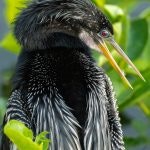Anhinga or Cormorant- How to Tell the Difference


October 12, 2023 By Katie Roundtree
Have you ever walked or driven by a lake in the area and seen a bird sitting by the side of the lake with their wings outstretched and wondered what they were doing? Two types of birds found in lakes around Palm Beach County display this activity: Anhingas and Cormorants. These birds with snake-like necks will perch by the water and spread their wings to dry after diving for food. When the Anhingas and Cormorants enter the water, their feathers get soaked because they don’t possess oil glands like other water birds. However, this allows them to move faster and more efficiently through the water. Their feathers soaked with water make them very heavy when they get out of the water. Therefore, they have to stand in the sun with their wings extended to dry themselves in order to fly again.
Anhingas and Cormorants look similar when spotted from afar. They are both dark in color, either black or dark brown. They both have long necks and dive to catch fish for food. However, there are many differences between the two. The first difference is the shape of their beak. Cormorants have a curved beak, while anhingas have a sharp, pointed beach. Cormorants eat primarily fish and can eat up to one pound of fish per day. Anhingas eat fish, crabs, frogs and other invertebrates. They use their pointed beak to stab their prey and bring it back to shore to eat.
Anhingas have longer necks and fuller, longer tails than cormorants. The anhinga’s nickname is the water turkey due to the size of its tail. Their other nickname is snake birds since their neck is as long and curved as a snake. They can be seen swimming slowly through the water with only their necks and head above the surface. Cormorants are more compact and are powerful swimmers. They use their webbed feet to dive deep and catch larger fish.
Their plumage and eyes are also slightly different from each other. The anhinga is slim with white markings on its back, like a coat of light-colored feathers, and blue-green to reddish-colored eyes. The cormorant is stockier than the anhinga, with no markings on its back and crystal blue eyes.
Finally, the two types of birds vary in how they fly through the air. Anhingas soar and flap their wings occasionally once their wings are dry. They need a taller platform to take off from to soar through the sky. Cormorants flap their wings the whole time they fly, allowing them to take off more easily from the ground than anhingas.
Next time you see one of these dark-colored birds with their wings outstretched, try to see if you can tell if they are an anhinga or a cormorant. Remember, “C” for a curved beak and wearing basic black is a cormorant, and if it has a sharp, pointed beak, long tail, and wearing a light- colored jacket, it’s the water turkey or anhinga.
